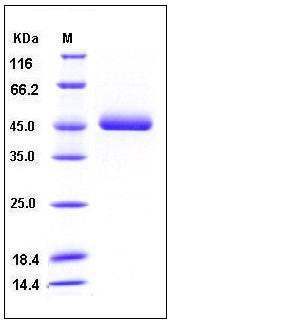Human Renin Protein (His Tag)
FLJ10761,HNFJ2,REN
- 100ug (NPP4218) Please inquiry
| Catalog Number | P10969-H08H |
|---|---|
| Organism Species | Human |
| Host | Human Cells |
| Synonyms | FLJ10761,HNFJ2,REN |
| Molecular Weight | The secreted recombinant human Renin is a monomeric protein after cleavage of the signal peptide. The pro form consists of 394 amino acids and predictes a molecular mass of 43.7 kDa. In SDS-PAGE under reducing conditions, it migrates with the apparent molecular mass of 50 kDa due to glycosylation. |
| predicted N | Leu 24 |
| SDS-PAGE |  |
| Purity | > 95 % as determined by SDS-PAGE |
| Protein Construction | A DNA sequence encoding the human Renin (NP_000528.1) precursor (Met 1-Arg 406) was expressed with a polyhistidine tag at the C-terminus. |
| Bio-activity | Measured by its binding ability in a functional ELISA. Immobilized human RENIN-His (P 10969-H08H) at 10 μg/ml (100 μl/well) can bind biotinylated human AGT-His (P 10994-H08H) with a linear range of 0.156-5.0 μg/ml. |
| Research Area | Cardiovascular |Blood |Other in Blood |
| Formulation | Lyophilized from sterile 25mM MES, 150mM NaCl, pH6.5 1. Normally 5 % - 8 % trehalose, mannitol and 0.01% Tween80 are added as protectants before lyophilization. Specific concentrations are included in the hardcopy of COA. |
| Background | Mouse Renin-1, also known as Ren-1, Angiotensinogenase and Kidney renin, is a member of the peptidase A1 family. Renin-1 is synthesized by the juxtaglomerular cells of the kidney in response to decreased blood pressure and sodium concentration. androgen and thyroid hormones influence levels of Renin-1 in mouse submandibular gland (SMG) primarily by regulating the amount of Renin-1 mRNA available for translation. Renin-1 is a highly specific endopeptidase, whose only known function is to generate angiotensin I from angiotensinogen in the plasma, initiating a cascade of reactions that produce an elevation of blood pressure and increased sodium retention by the kidney. It is expressed at relatively low levels in mouse SMG and kidney. Ren-2 is expressed at high levels in the mouse SMG and at very low levels, if at all, in the kidney. Ren-1 and Ren-2 are closely linked on mouse chromosome 1, show extensive homology in coding and noncoding regions and provide a model for studying the regulation of gene expression. |
| Reference |
